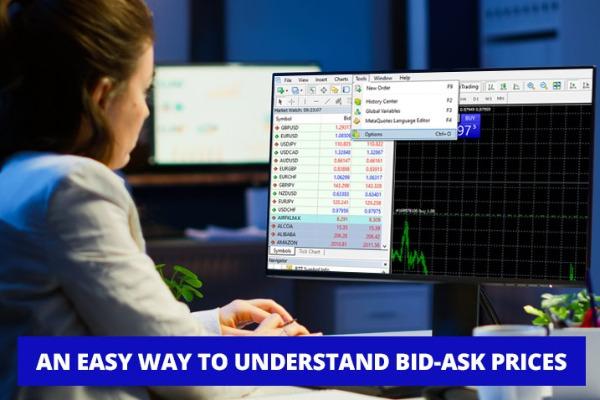Did you know that there are several brokers with trading platforms allowing both hedging and netting? What are the differences between the two options?
Every trader should know that they need a trading strategy before entering the forex market. There are many trading strategies to choose from, each has its own characteristics and difficulties. Every trader is free to choose any strategy that suits them and goes well with their trading habits. Typically, traders would choose a forex broker that supports their trading strategy and provides other trading tools as an addition to make their trades even more successful.

However, there is one trading technique that is considered illegal in the US: Hedging. In 2009, the National Futures Association (NFA) had sparked a stir in the forex industry by introducing the new FIFO (First In, First Out) policy. The policy basically prohibits US forex traders from hedging the same currency pair. This rule is then applied to all US-based forex brokers.
Not long after, several trading technology companies refined a platform that is equipped with anti-hedging features to avoid illegal hedging practices. Unfortunately, this idea was firmly rejected by forex traders outside the US. As a result, companies and brokers provide a new option called hedging and netting, which can be activated or deactivated based on the trader's account type.
So what is the difference between hedging and netting? What are the advantages of each type? Read the rest of the article to find out.
Hedging: Flexible in Every Way
To put it simply, forex hedging is a trading method that allows the trader to open several positions at once, either in the same or different currency pair. The goal is to protect the trading funds from unfavorable conditions and reduce the risk of getting significant losses if the price suddenly goes against the trade.
The principle of hedging is that each of the new positions opened will be recorded as a separate trade from the last one. So, for example, you buy 1 lot of GBP/USD and an hour later you sell 0.5 lot of the same currency pair. The two trading positions will then be recorded separately in the history of your transaction. If the buy order turns out to move in an unfavorable way, you can close it and let the sell position floats to gain profits. Although you lose from the first position, the amount of loss would be mitigated by the profit from the second position.
If you're still unsure about the price's direction, you can keep both positions open until you get a clear signal from the chart. It would be helpful to set a stop loss level beforehand, so you are unlikely to lose too much. However, letting both positions afloat like that for a long time can potentially be a disaster because if both positions reach the stop loss level, then you will get double loss and spread. Therefore, make sure to assess the situation and manage the risk wisely.
Some of the advantages of using a hedging strategy are:
- You can open multiple (long and short) positions with any trading instruments.
- You can apply different stop loss and take profit levels for each trading position.
- You can see an overview of the many trading positions on the chart.
In contrast, the drawback of using hedging is that the transaction list can be too long and messy. On top of it, you must be able to calculate the breakeven point of all trading volumes on a single pair.
Netting: A Simpler Risk Management System
If you are still unfamiliar with the word netting, it basically means a trading method that only lets you have one position opened in one currency pair. So if you open two trading positions simultaneously, then it will automatically be counted as one, and the second position can add, reduce, or even close the previous trading volume. So in netting, opening multiple positions means combining them to produce a final net position. In contrast to hedging, netting the two positions will be recorded as one trade in the transaction history.
For example, you buy 1 lot of GBP/USD, then an hour later, you sell 0.5 lot of the same currency pair. Right after you opened the second position, the buy position that was opened earlier will be partially closed by the system. This situation can happen multiple times, so you can open more positions to add or reduce trading volumes from the last position.
See Also: Lowest Spread Forex Brokers For GBP/USD
If you set a stop loss level, it will be placed according to the previous position opened. In other words, stop levels in each subsequent order will replace the previous ones. If a position is partly closed, stop loss and take profit will not be changed by the new position. But if a position is fully closed, stop loss and take profit will be d because they initially came with the previous position and so it cannot exist without it.
The advantages of using netting in forex trading are as follows:
- You only need to manage one trading position in a single currency pair so you can save more time and energy.
- You can easily calculate the breakeven point of all trading volumes of a pair.
- You can reduce the risk of conflicting trading positions in which one position is gaining while the other is losing.
Netting has its own disadvantages; it makes it impossible for you to set a stop loss and take profit for each trading position separately. Merging the multiple positions into one will then force you to be more careful in analyzing the price movement and so it reduces the flexibility of trading compared to hedging. Also, you need to be extra careful when placing a pending order because it is possible that the previous trading position is still opened when the pending order is triggered.
Hedging and Netting in Forex Brokers
Hedging and netting features are somewhat rarely discussed among MetaTrader 4 users. The reason is that this extremely popular platform only allows its users to hedge, so traders can choose to perform hedging without having to use netting as an alternative. Generally speaking, forex traders prefer to use hedging because it is considered more flexible and can potentially bring more profits. By opening multiple positions at once, they can reduce the amount of loss while at the same time, hoping for the other positions to cover the loss and gain extra profit. However, there are also some traders who prefer netting because the risk management is simpler. They only have to focus on one position and gain profit as much as possible.
Other than that, it is also worth noting that not all trading platforms support both hedging and netting features. By default, most old trading platforms only allow the hedging system. The pioneers that brought together hedging and netting features were the cTrader platform, followed by MetaTrader 5, and a number of proprietary platforms from certain forex brokers (especially from the US). By using these newer platforms, traders can choose to do hedging or netting depending on their needs and preferences.
For your information, the more recently released MetaTrader 5 originally directed its users to the netting system. If a trader tries to open a second position in the opposite direction of the first position, the platform will automatically net the number of trading volumes and partially or fully close the position.
However, after years of high demand from international traders, MetaQuotes decided to add the hedging system to the platform, which then could attract more brokers so they could begin offering this feature to clients. Now traders can maximize the use of their strategy, whether it is hedging or netting using this platform. In this case, brokers can choose to enable or disable this functionality, as some regulators, especially in the US, do not permit hedging practices.
The Bottom Line
From the explanation above, it can be concluded that the main difference between hedging and netting lies in the accounting system of the trading positions that are being opened. In the hedging system, the two positions are counted separately in the trader's transaction history, while in the netting system, the multiple positions are counted as one open position.
As for the question of which system is better, it all comes back to the trader's preference. We mentioned that some traders think that hedging is more flexible because they are more flexible. But in some cases, managing multiple open positions can be complicated. Hence, they prefer to use netting that simplifies risk management by only focusing on one open position.
Apart from that, don't forget to check your broker along with its regulator, whether they allow hedging and netting practices or not. Also, check if the provided trading platform only allows a hedging system, netting system, or both. Should you prefer to use hedging over the netting, learn how to choose the best forex broker for hedging.

 Dedicated FREE FOREX VPS
Dedicated FREE FOREX VPS Free FOREX Virtual Private Server
Free FOREX Virtual Private Server MT4 Demo Contest, Get $500
MT4 Demo Contest, Get $500 Sign Up for an Account, Claim 60% Deposit Bonus
Sign Up for an Account, Claim 60% Deposit Bonus Free MT4/MT5 VPS 2024
Free MT4/MT5 VPS 2024 Send E-mail and Get Free Merchandise
Send E-mail and Get Free Merchandise $1K Refer a Friend Bonus for Pepperstone Pro clients
$1K Refer a Friend Bonus for Pepperstone Pro clients Maximize Your Earnings with 100% Deposit bonus
Maximize Your Earnings with 100% Deposit bonus Trade to Win, $5,000 Monthly Demo Contest
Trade to Win, $5,000 Monthly Demo Contest Claim 30% + 15% Deposit Bonus from LiteFinance
Claim 30% + 15% Deposit Bonus from LiteFinance












7 Comments
Lidya
Jul 7 2023
I totally get your admiration for hedging strategies, lah. It's a common and intriguing concept in the forex world, right? I'm curious too, what risks should beginners be aware of when it comes to hedging, eh? I understand that hedging involves opening multiple positions to protect trading funds and minimize the risk of significant losses. However, since each position is recorded separately and the goal is to offset losses with gains from other positions, I wonder if there are any specific risks that beginners should watch out for, you know? And how can beginners effectively navigate the complexities and challenges that come with implementing hedging strategies, lah?
Herry
Jul 11 2023
@Lidya: Hey! I totally get your fascination with hedging strategies. They can be pretty intriguing in the forex world. But, you know, it's important for beginners to be aware of some risks that come with hedging. First off, hedging can have extra costs like spreads, commissions, and higher margin requirements, which can eat into profits. Plus, you gotta watch out for the correlation between your hedging positions. If they're not properly aligned or if market conditions suddenly change, your hedging might not protect you from losses as expected.
Hedging can be a bit tricky too, so it's vital to understand market trends, price movements, and how economic factors play into it. You can use risk management tools like stop-loss orders and take-profit levels to set clear exit points. Start small, gain experience, and gradually increase your positions.
Frida
Jul 12 2023
Imagine you be trader wey dey use hedging and netting strategies well-well. You believe say fast execution na key thing to carry out your trades effectively and manage risk. But e be like say opinions dey split on whether brokers need to offer fast execution for these strategies. Some traders talk say quick execution dey important to quickly set up hedges, while others dey talk about the simplicity and risk management benefits of netting wey no need immediate execution. Wetin you think about this matter? You believe say brokers need to give fast execution to fit handle hedging and netting strategies, or you feel say e depend on personal preferences and the specific requirements of each strategy? Share your insights and experiences on top the importance of execution speed for hedging and netting scenarios.
Andrew
Jul 13 2023
@Frida: As a trader who loves hedging and netting strategies, let's talk about execution speed. Some say it's super important, while others think it's not a big deal. Here's the scoop: it really depends on your personal preferences and the requirements of your strategy.
If you're into hedging, where you offset potential losses with opposing positions, fast execution is a game-changer. Being able to establish hedges quickly helps you manage risk like a pro and keep your portfolio balanced. So, brokers offering fast execution can be a real lifesaver for hedging traders.
But wait, there's more! Netting strategies are all about simplifying risk management by consolidating positions into one. Unlike hedging, netting doesn't always require immediate execution. Sure, efficient execution is still important, but it doesn't have to be lightning-fast for netting strategies to work their magic.
At the end of the day, the need for speedy execution in hedging and netting comes down to your own style and strategy. Some traders live for lightning-fast execution, while others focus on different factors like pricing or platform reliability.
So, trust your gut, consider your trading goals, and find the right balance for you. Talk to other traders, learn from their experiences, and figure out what execution speed works best for your hedging or netting adventures. Happy trading!
Wilson
Jul 14 2023
Can you clarify if it's possible to add orders in netting trading method, or do brokers need to allow netting in order to execute trades? I'm trying to understand the concept of netting, where only one position is allowed in a currency pair, and any additional positions automatically combine with the existing position. In netting, opening multiple positions merges them into a final net position, unlike hedging where each position is recorded separately. Could you shed some light on the possibility of adding orders and whether brokers need to enable netting for traders to engage in this type of trading?
Alex
Jan 17 2024
Hey, I've got a question about Netting. It's mentioned that Netting comes with its drawbacks – specifically, it prevents you from setting individual stop loss and take profit levels for each trading position. Combining multiple positions into one makes it necessary to be extra cautious when analyzing price movements, ultimately limiting the flexibility of trading compared to hedging. Additionally, the explanation goes like this: if you open two trading positions simultaneously, they automatically merge into one, and the second position has the ability to add, reduce, or even close the previous trading volume.
So, I'm curious about examples of Netting or if someone can illustrate how it works. And, on a practical note, how do you activate Netting in trading?
Dios
Jan 20 2024
Hey there! Let's break down an example to illustrate how Netting works:
Imagine you open two trading positions in the foreign exchange market:
Now, under Netting, these positions are automatically combined into a single position. The system considers the net effect of both trades, which, in this case, is a Buy position of 2,000 units of USD/JPY (10,000 units from Position A minus 8,000 units from Position B).
If you decide to add more volume, say by buying an additional 5,000 units of USD/JPY, the new position will be integrated into the existing netted position. Now, you effectively have a Buy position of 7,000 units of USD/JPY.
Conversely, if you choose to close part of your position by selling 3,000 units of USD/JPY, the system adjusts the netted position accordingly. In this case, your netted position would now be a Buy position of 4,000 units of USD/JPY.
However, keep in mind that setting individual stop loss or take profit levels for the initial positions (A and B) separately isn't possible in a Netting scenario. The stop loss and take profit would apply to the overall netted position. Hope it can help you!